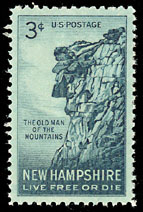Too many of us the very thought of gold mining produces visions of the California gold rush or trekking into the Klondike during the Klondike Gold Rush. Our thoughts immediately bring up the picture of some grizzled old prospector with a donkey looking for gold in some far-off desert, or a frozen waste in some icebound part of the far North. To everyone's surprise gold is not unknown in the Granite State of New Hampshire.
When some New Hampshire California New Hampshire Grafton County New Hampshire
 |
| A postage stamp of the Old Man of the Mountains New Hampshire's state symbol that used to be in Franconia Notch |
Gold is considered a noble metal because it resists corrosion and any other kind of chemical weathering it is only dissolved by a mixture of nitric acid and hydrochloric acid that is called aqua regia or in solutions of alkaline metal cyanide usually in the form of potassium cyanide. It also combines with mercury to form a gold/mercury amalgamate. Many of its unique properties are taken advantage of in the process of refining gold. It is also the same standoff property from other elements that causes gold to be found in its native form sometimes almost pure, and at other times alloyed with silver in a pale brassy colored metal called electrum.
 |
| Gold Panning in New Hampshire Photo by Alan Souter |
Gold is extremely malleable so that it can be beaten into thin sheets only a few atoms thick that are called goldleaf that is used for gilding many objects of art. It is the same property that forms gold nuggets it's in streams when the metal is being transported by water.
Gold is found in lode deposits where it is held loosely in the intracrystalline spaces in quartz veins as a special alloy with silver that is called electrum, As disseminated deposits like the deposits in Nevada
Gold is one of the metals that tends to be fractionated from late stage hydrothermal fluids that form during the cooling of igneous rocks such as granite. In rock metamorphism gold tends to be quite mobile especially when the rocks hold an abundant amount of brine, usually a salty brine.
.jpg/800px-Bath-Haverhill_Bridge,_Spanning_Ammonoosuc_River,_bypassed_section_of_Amm,_Woodsville_(Grafton_County,_New_Hampshire).jpg) |
| The Ammonoosuc River spanned by a covered bridge at Bath, New Hampshire |
Gold is usually associated with granitic rocks, but also with those rocks that are known serpentinite that theoretically are fragments of rock from the ocean bottom that were originally basalt that have been altered into serpentine by the process of metamorphism. Another name for serpentinite is greenstone and it is assumed that greenstone contained gold that was leached out by the action of salt brine and deposited in quartz veins. One of the largest greenstone belts in the world is the Abitibi Gold Belt found in Québec and Ontario , Canada
For the most part now that rocks that are now abundant in the state are usually found associated with the granitic rocks of the White Mountains . It is estimated that about 50% of the rocks in the state are metamorphic that in part are derived from rocks that were originally of volcanic origin.
 |
| Mount Washington from Bretton Woods Photo by W. Woods |
In New Hampshire most groundwater contains trace amounts of gold that is usually less than 1 ppb for the most part are of scientific interest only but can be used for geochemical exploration that is often be used for locating lode deposits of gold and other metals.
.
Although gold can be found widely dispersed across the entire state of New Hampshire
Such lode deposits however are an important source of specimens for the rock and mineral collectors that are found throughout the state. Placer gold is Gold that has been weathered out of rocks and has been transported by water and redeposited in the bed of streams. Placer deposits are often found on beaches or offshore marine sediments especially when they are near the mouths of rivers and streams entering the sea.
 |
| It would be nice if this gold was found in New Hampshire, but it came from Alaska Photo by Alaskan Miner |
In the state of New Hampshire New Hampshire
You can get detailed information about permitting from:
Phone (603) 271 – 2147
The use of power equipment is not permitted in the White Mountains National Forest
Even though gold mining has never been done on a commercial scale in New Hampshire mining interest dates all the way back to colonial times with the possibility of a major gold find being found within the context of modern gold genetic models similar to the Carlin trend in Nevada.
There have been found in New Hampshire Ammonoosuc River Grafton County
A bit later in 1878 a smaller amount of gold that was shipped to the Philadelphia Mint that was produced at Diamond Ledge mine in Ossipee. The richest area in the state is centered on the Ammonoosuc district where it is found in veins of sulfide minerals such as pyrite for his free gold that is the positive in quartz veins, or dispersed in sheared chloritic schist.
The Ammonoosuc Gold District is centered on the towns of Lyman, Monroe Bath Western Lisbon extending north to the Connecticut Lakes Connecticut River in this district are all likely to be gold bearing.
.